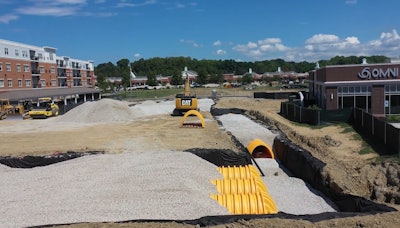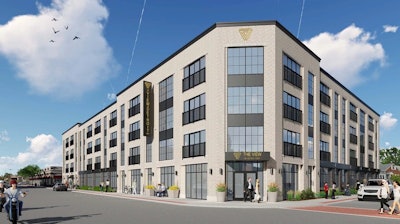
Winning work based on bidding is hard enough—success depends on solid estimating, performance against the project plan and good communication. Design-builders have an even more complex task, as they start not at a set of plans but with the project owner’s broad wishes and expectations, and must guide the owner toward a vision, and then successfully execute against that vison.
This is the challenge faced by Willloughby, Ohio-based Marous Brothers Construction, which delivers work through multiple project delivery systems including design-build and construction management across sectors including multi-family, commercial, office, industrial, education, senior living, healthcare, retail and others. The company employs about 200, self-performing essential portions of projects including sitework, excavating, carpentry and interior finishes. Its focus on quality, on-time delivery and transparency have been essential tools to support growth, and according to Marous Brothers Director of Business Development Arne Goldman, more than 90% of the contractors’ projects come from repeat customers.
“We are having our biggest year ever,” Goldman said. “We are now about 20% over last year, and grew 10% the year before and 5% the year before that,” Goldman said. “We negotiate 90% of our work, so we are not running a customer relationship management (CRM) software tool because our clients find us. We are often involved in projects before the architect is selected.”
This relationship-centric approach to construction has made Marous Brothers a contractor of choice for customers including Caterpillar, which has worked with them on multiple projects including Ohio Cat Headquarters in Broadview Heights, Ohio. The 62,250-square foot project includes shop space, a parts warehouse and office space. Marous Brothers has built Cat rental stores in the state as well, and coincidentally relies on an all-Caterpillar heavy equipment fleet that makes heavy use of equipment guidance technologies to increase quality and consistency.
The company also relies on drones to survey larger greenfield construction projects, mostly to determine logistical tactics—including the ideal approach for truck access, traffic patterns in nearby intersections and where a job trailer should be positioned.
But the most powerful takeaways from Marous Brothers’ approach to construction technology is in the back office.
Construction Software-Enabled Workflow
Once an owner engages with this design-build contractor, Marous Brothers relies on a portfolio of enterprise tools to support operations and facilitate good communication with project owners. The contractor uses a cloud-based instance of Viewpoint, now owned by Trimble as part of Trimble Construction One—for project management.
What is Trimble Up to with Viewpoint? Exclusive Insight Here!
“Years ago, we used (Meridian Systems) Prolog and other software products,” Goldman said. “But we have found that as a contractor with large projects in the area of hundreds of millions of dollars in multiple states, it became very important to have the ability to have our accounting and project management software talk to each other.”
Marous’s instance of Viewpoint is paired with a cloud instance of Sage 100 Contractor, formerly Master Builder, which is used for estimating and financials. An instance of the On-Center Software’s On Screen desktop takeoff product is integrated with Sage 100 Contractor, driving the takeoff data into the start of the process. Other applications including the company’s instance of Autodesk Revit for building information modeling and an on-premise instance of Oracle Primavera P6, are stand alone. More integration would help eliminate manual steps according to Goldman, but the current process flow has been supporting the company’s growth trajectory.
“Sage Timberline ties into our database of historical cost, and On Screen is the software solution that allows us to make a digital capture of drawings for instantaneous takeoffs and estimates,” Goldman said. “The takeoffs seed the Sage system, and we can then make adjustments to the estimates in that application. Sage is working very well for our 35 estimators.”
Once an estimate is accepted, Marous Brothers uses Primavera for scheduling.
See how estimates come together in Sage 100 in this IronPros Product Snapshot Video
Toward Construction Software Interoperability
“Primavera is not integrated” Goldman said. “I wish it was. But it is good with resource loading, scheduling and helping us identify the critical tasks required for the critical path method (CPM) of project management.”
Oracle does offer a number of ways to integrate Primavera P6 with other softwares, but the preferred method for integration has changed. For years, Primavera P6 users would pull data into the application using the P6 SDK to import a work breakdown structure, but Oracle says this technique should no longer be used to support integrations. Primavera P6 users can also leverage the P6 Professional API which provides access to a functionality inside of Primavera, but this method has been deprecated in favor of newer technology. Oracle now pushes customers like Marous toward Primavera Web Services and encourages them to move to Oracle Primavera Cloud which has its own Integration App.
For a company like Marous Brothers, using any of these would likely require the work of a systems integrator, but Agave, an integration platform as-a-service (iPaaS) company, is working on adding Primavera P6, Viewpoint Visa and Sage to their portfolio of standard integrations, and competitor Ryvit already covers Viewpoint Vista and Sage 100 Contractor. HH2 was hired by Sage to build APIs into Sage 100 Contractor and Sage 300 Construction and Real Estate and includes these products and the Viewpoint products in their current platform. Once added to the list of iPaaS-supported products, all three solutions will be accessible and interoperable under a single, standard API. These iPaaS offerings from Agave, Ryvit and HH2 are akin to a Rosetta Stone that translates data formats from one application and maps it to fields in another for bidirectional integrations.
“We are a newer company, and focus on different software,” Agave Co-Founder Tom Reno said to contrast his company from others in the space. “Ryvit, HH2—they focus on very specific systems, more legacy and on-premise systems. Those products are very widely used, and have large market share. We cover 100% cloud-based systems. We are developing a way not to integrate with on-premise systems so if you are a general contractor and your accounting system lives within your firewall but you need to connect with other systems for cloud-based purchase orders or payments, that is hard problem to solve.”
Because scheduling in Primavera is currently stand-alone, Goldman said Marous Brothers employees need to manually input data and then handle rework if they make changes to materials or other project variables in Sage in order to see how it affects the schedule.
Most of the time, Marous Brothers enters into a preconstruction agreement before they begin delivering any services, so generally they are not providing a bid against a plan. Actions in their various systems of record are triggered by this Instrument of Service, including an initial project meeting where meeting minutes are captured in Viewpoint.
“At the initial project meeting, we would try to get information about the client budget and expectations—and test that with an initial project schedule,” Goldman said.
Then, they engage with the project owner’s design team or with their internal staff that created the design in Revit to generate a baseline budget using Sage 100 Contrator and On Screen to capture concept drawings for takeoff.
Using the takeoff and Sage estimating, Marous Brothers models a broad project schedule in Primavera, making sure it reflects any preconstruction activities, entitlements and other critical elements.
“We try to model a reasonable duration,” Goldman said. “When you do negotiated work, clients want a very early recognition of cost, very early recognition of schedule and clear integration of quality and scope.”
Once a project is underway, Sage 100 Contractor generates project data in real time to support timely decisions.
“For every estimate in Sage 100 Contractor, the software divides reporting components and assembly,” Goldman said. “We have a way of constantly delivering delivery estimating and capturing new information. Once a project underway, transparency and communication become even more essential, and that is what we strive to deliver.”
Technology for Project Communication
Estimating, planning and sound execution are critical to delivering a positive owner experience an achieving project outcomes, but Marous Brothers also leverages its construction software tech stack for softer skills, including project communication with the owner.
“We use technology in our design-build projects often times to do initial drawings,” Goldman said. “This may be something we execute in Revit, and in some cases we opt for some rendering in colors or textures or maybe a 3D walkthrough.
What's New and Cool with Autodesk Revit? Exclusive Insights Here.
Marous Brothers leadership is sensitive to the needs and capacities of the owner personnel in determining how they package project materials for ease of comprehension.
“A lot depends on how graphically literate the clients are—whether they are comfortable with schematics and blueprints,” Goldman said. “We work hard to figure out the graphic and plan reading ability of our clients. The less graphically literate they are, the more important it is for us to do a 3D rendering or other visualizations. At the end of the day, we use technology to help us manage and deliver on expectations—our whole business is about managing and delivering on expectations."
 In order to help project owners understand a design, Marous Brothers may create renderings like this one of the proposed View on Detroit East mixed-use development in Lakewood, Ohio.Marous Brothers
In order to help project owners understand a design, Marous Brothers may create renderings like this one of the proposed View on Detroit East mixed-use development in Lakewood, Ohio.Marous Brothers
Marous Brothers also focuses on the usability and readability of project plans and estimates, and goes out of their way to ensure owners can easily grasp the content of documents.
“I think we have gotten great feedback on how easy our Sage output is for clients to understand,” Goldman said. “Sometimes, estimating software spits out a lot of numbers and other information that is undecipherable unless you know what you are doing. But even our layperson customers can understand that. We are able to customize things in Sage to make things easy for the owner—we can do a summary and Sage will spit out that summary based on the parameters we put in. Looking at that, the owner can quickly grasp the essentials like cost per square foot, whether there is a contingency and what our fees are. Sage does a more than decent job presenting things like this.”
Marous Brothers has to, on the other hand, massage and work around the way Primavera presents the project plan so it can be easily digestible.
“Unless you know how to read a schedule output, it is not exactly friendly,” Goldman said. “Sometimes in Powerpoint presentations, while we will have issued to the client a P6 schedule, we often use an Excel bar chart because the Primavera output is a little too technical.
Viewpoint, used for meeting minutes, is also used by the Marous Brothers team for project financials including outputs shared with project owners.
“We use Viewpoint for meeting minutes and financial reports,” Goldman said. “Even when we are working as a construction-manager-at-risk and we have specific fiduciary duties to our clients, Viewpoint is able to produce pretty good deliverables in terms of project costs. The product has gotten better at this as a matter of fact, and we are able to share these outputs without having to decipher them or repackage them in a more readable matter. The output can be streamlined to make it easier for our customers to comprehend.”
Technology for Customer Experience
From the front office functions that customers see directly like estimates to financial reporting to renderings to the back office functions like accounting and takeoffs, Marous Brothers has a thoughtful approach that has supported rapid growth. Theirs is not a technology-centric strategy—their processes are not completely digitized and there is room for growth. Their strategy is rather a customer-centric strategy that prioritizes clear and transparent communication and reliable delivery.





















